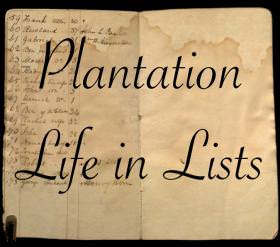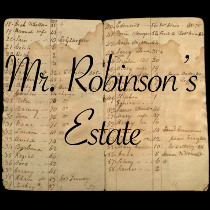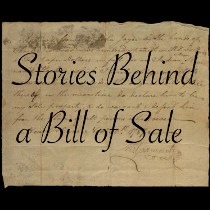Plantation Life in Lists
 Slavery played a prominent and expansive role in white society in the South. Because it was a legal institution, some of the most complete historical sources available to us are the numerous documents created to memorialize the transactions and expenses related to enslaving millions of people. These range from court records, contracts, and receipts to the everyday records of what was, for the slave owners, often simply another aspect of the business and financial records.
Slavery played a prominent and expansive role in white society in the South. Because it was a legal institution, some of the most complete historical sources available to us are the numerous documents created to memorialize the transactions and expenses related to enslaving millions of people. These range from court records, contracts, and receipts to the everyday records of what was, for the slave owners, often simply another aspect of the business and financial records.
Slavery played a prominent and expansive role in white society in the South. Because it was a legal institution, some of the most complete historical sources available to us are the numerous documents created to memorialize the transactions and expenses related to enslaving millions of people. These range from court records, contracts, and receipts to the everyday records of what was, for the slave owners, often simply another aspect of the business and financial records.
The first item in this collection is the 1826 appraisal of the estate of a Mr. Robinson, who had recently died. Of special importance is the index of the 76 slaves that Robinson had owned, as well as some identifying comments regarding them. These compel us to consider the uncertainties that faced the enslaved after their master’s death, as well as how an enslaved person was seen to an “appraising eye.” Adding context to that document are several accounting notebooks that were kept by three members of the Reid Family, a Virginia family whose respective generations served in a federal court and a secessionist legislature. The notebooks detail business interactions with the enslaved, with everything from purchases made from them to clothing and provisions rationed out to them. This collection compels us to ask what passionless record keeping can reveal about the day-to-day lives of enslaved men, women, and children.
Teacher notes:
As students begin to explore the primary sources in this section, it is likely they will need significant guidance in seeing the underlying context. An opening activity or initiation might involve the teacher providing all of the receipts collected over the period of a week. Grocery store, gas station, convenience store, coffee shop, and bills paid are all windows into how we spend our time and money. Make copies and ask groups of students to write a very short biography of you based on the documents. A variation might be to ask three teachers in the school to give you copies of their receipts and to ask the student groups to write a biography from each one and then match it with the teacher.
One of the first questions to have students explore with these slavery sources, and this goes for almost every source, is: Why was this primary document created? As they move through the lists and records, ask students to explore the reason each one was created, how its creator intended it to be used, and why it survived all these years to reach us today. This will help them to see the pervasive reach of slavery and how what appear to be routine sources can help us discover important aspects of the past.
- Given what you can learn about the families included in Mr. Robinson’s estate, what would have been the most significant challenges they would have had to overcome to foster their own family life?
- Which of the six documents in the “Bills of Sale” section provides the most insight into its society? Does it tell us more about the enslaved or the enslaver?
Some possible compelling and guiding questions include:
-
Given what you can learn about the families included in Mr. Robinson’s estate, what would have been the most significant challenges they would have had to overcome to foster their own family life?
-
HWhich of the six documents in the “Bills of Sale” section provides the most insight into its society? Does it tell us more about the enslaved or the enslaver?


